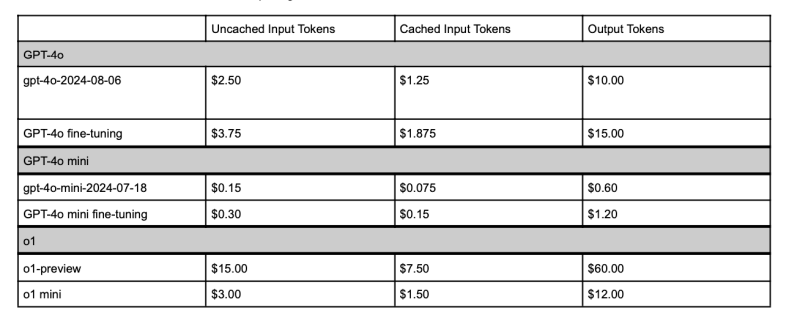OpenAI’s DevDay 2024: 4 major updates that will make AI more accessible and affordable
Join our daily and weekly newsletters for the latest updates and exclusive content on industry-leading AI coverage. Learn More
In a marked contrast to last year’s splashy event, OpenAI held a more subdued DevDay conference on Tuesday, eschewing major product launches in favor of incremental improvements to its existing suite of AI tools and APIs.
The company’s focus this year was on empowering developers and showcasing community stories, signaling a shift in strategy as the AI landscape becomes increasingly competitive.
The company unveiled four major innovations at the event: Vision Fine-Tuning, Realtime API, Model Distillation, and Prompt Caching. These new tools highlight OpenAI’s strategic pivot towards empowering its developer ecosystem rather than competing directly in the end-user application space.
Prompt caching: A boon for developer budgets
One of the most significant announcements is the introduction of Prompt Caching, a feature aimed at reducing costs and latency for developers.
This system automatically applies a 50% discount on input tokens that the model has recently processed, potentially leading to substantial savings for applications that frequently reuse context.
“We’ve been pretty busy,” said Olivier Godement, OpenAI’s head of product for the platform, at a small press conference at the company’s San Francisco headquarters kicking off the developer conference. “Just two years ago, GPT-3 was winning. Now, we’ve reduced [those] costs by almost 1000x. I was trying to come up with an example of technologies who reduced their costs by almost 1000x in two years—and I cannot come up with an example.”
This dramatic cost reduction presents a major opportunity for startups and enterprises to explore new applications, which were previously out of reach due to expense.

Vision fine-tuning: A new frontier in visual AI
Another major announcement is the introduction of vision fine-tuning for GPT-4o, OpenAI’s latest large language model. This feature allows developers to customize the model’s visual understanding capabilities using both images and text.
The implications of this update are far-reaching, potentially impacting fields such as autonomous vehicles, medical imaging, and visual search functionality.
Grab, a leading Southeast Asian food delivery and rideshare company, has already leveraged this technology to improve its mapping services, according to OpenAI.
Using just 100 examples, Grab reportedly achieved a 20 percent improvement in lane count accuracy and a 13 percent boost in speed limit sign localization.
This real-world application demonstrates the possibilities for vision fine-tuning to dramatically enhance AI-powered services across a wide range of industries using small batches of visual training data.
Realtime API: Bridging the gap in conversational AI
OpenAI also unveiled its Realtime API, now in public beta. This new offering enables developers to create low-latency, multimodal experiences, particularly in speech-to-speech applications. This means that developers can start adding ChatGPT’s voice controls to apps.
To illustrate the API’s potential, OpenAI demonstrated an updated version of Wanderlust, a travel planning app showcased at last year’s conference.
With the Realtime API, users can speak directly to the app, engaging in a natural conversation to plan their trips. The system even allows for mid-sentence interruptions, mimicking human dialogue.
While travel planning is just one example, the Realtime API opens up a wide range of possibilities for voice-enabled applications across various industries.
From customer service to education and accessibility tools, developers now have a powerful new resource to create more intuitive and responsive AI-driven experiences.
“Whenever we design products, we essentially look at like both startups and enterprises,” Godement explained. “And so in the alpha, we have a bunch of enterprises using the APIs, the new models of the new products as well.”
The Realtime API essentially streamlines the process of building voice assistants and other conversational AI tools, eliminating the need to stitch together multiple models for transcription, inference, and text-to-speech conversion.
Early adopters like Healthify, a nutrition and fitness coaching app, and Speak, a language learning platform, have already integrated the Realtime API into their products.
These implementations showcase the API’s potential to create more natural and engaging user experiences in fields ranging from healthcare to education.
The Realtime API’s pricing structure, while not inexpensive at $0.06 per minute of audio input and $0.24 per minute of audio output, could still represent a significant value proposition for developers looking to create voice-based applications.
Model distillation: A step toward more accessible AI
Perhaps the most transformative announcement was the introduction of Model Distillation. This integrated workflow allows developers to use outputs from advanced models like o1-preview and GPT-4o to improve the performance of more efficient models such as GPT-4o mini.
The approach could enable smaller companies to harness capabilities similar to those of advanced models without incurring the same computational costs.
It addresses a long-standing divide in the AI industry between cutting-edge, resource-intensive systems and their more accessible but less capable counterparts.
Consider a small medical technology start-up developing an AI-powered diagnostic tool for rural clinics. Using Model Distillation, the company could train a compact model that captures much of the diagnostic prowess of larger models while running on standard laptops or tablets.
This could bring sophisticated AI capabilities to resource-constrained environments, potentially improving healthcare outcomes in underserved areas.
OpenAI’s strategic shift: Building a sustainable AI ecosystem
OpenAI’s DevDay 2024 marks a strategic pivot for the company, prioritizing ecosystem development over headline-grabbing product launches.
This approach, while less exciting for the general public, demonstrates a mature understanding of the AI industry’s current challenges and opportunities.
This year’s subdued event contrasts sharply with the 2023 DevDay, which generated iPhone-like excitement with the launch of the GPT Store and custom GPT creation tools.
However, the AI landscape has evolved rapidly since then. Competitors have made significant strides, and concerns about data availability for training have intensified. OpenAI’s focus on refining existing tools and empowering developers appears to be a calculated response to these shifts. By improving the efficiency and cost-effectiveness of their models, OpenAI aims to maintain its competitive edge while addressing concerns about resource intensity and environmental impact.
As OpenAI transitions from a disruptor to a platform provider, its success will largely depend on its ability to foster a thriving developer ecosystem.
By providing improved tools, reduced costs, and increased support, the company is laying the groundwork for long-term growth and stability in the AI sector.
While the immediate impact may be less visible, this strategy could ultimately lead to more sustainable and widespread AI adoption across many industries.
Source link


